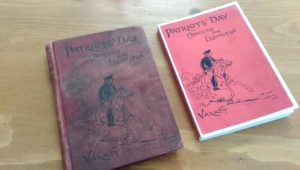It’s with great pleasure that I announce that we at Battle Road Books have produced a replica of this wonderful little book: Patriots’ Day by George Varney
Our goal at Battle Road Books is to keep the history of the Revolutionary War alive and vibrant and easily accessible. We also don’t think you should pay an arm and a leg just to read these old books.
On the left is the original book. It’s a little book – I’m finding that many of the old books I’m buying are small – just a bit smaller than 5″x7″. On the right, of course, is the “reincarnation.” It is not a scanned copy – have you seen those? – they’re a mess. Nope. We lovingly went through every page of this book and made each page as close to the original as possible.
It is a book that was produced in 1895, written by George Varney, as a celebration of the 100th anniversary of the Battles of Lexington and Concord. I love this book and am thrilled that you’ll be able to love it too.
Here’s the Preface:
PREFACE
The bill abolishing the practice of appointing annually a day of ”fasting and prayer,” having passed the Massachusetts House of Representatives, received the approving vote of the Senate on March 16, 1894, and was on the same day signed by the governor, Frederic T. Greenhalge. The bill also established the nineteenth day of April as an annual holiday. The latter, therefore, is the legitimate successor of Fast Day, which had come to be observed chiefly by its desecration.
The first proclamation of the new holiday was issued on the eleventh day of April, 1894, and gave it, most appropriately, the name Patriots’ Day. Neither the statute nor the proclamation prescribed any definite form of celebration; consequently, there is ample scope and freedom for the preferences of communities and organizations in its observance. The proclamation was as follows: —
”By an act of the Legislature, duly approved, the nineteenth day of April has been made a legal holiday.
”This is a day rich with historical and significant events which are precious in the eyes of patriots. It may well be called Patriots’ Day. On this day, in 1775, at Lexington and Concord, was begun the great war of the Revolution; on this day, in 1783, just eight years afterwards, the cessation of war and the triumph of independence were formally proclaimed; and on this day, in 1861, the first blood was shed in the war for the Union.
”Thus the day is grand with the memories of the mighty struggles which in one instance brought liberty, and in the other union, to the country.
”It is fitting, therefore, that the day should be celebrated as the anniversary of the birth of Liberty and Union.
”Let this day be dedicated, then, to solemn religious and patriotic services, which may adequately express our deep sense of the trials and tribulations of the patriots of the earlier and of the latter days, and also especially our gratitude to Almighty God, who crowned the heroic struggles of the founders and preservers of our country with victory and peace.”
It is earnestly and devoutly to be desired that the sentiments of this proclamation shall imbue every breast; that patriotism shall more and more take the form of
religion, holding relation, not to one nation only, but to all the peoples of the earth; that the happy time may come when justice, forbearance, and magnanimity will so prevail among men that violent and destructive differences between individuals, communities, states, and nations will be prevented by wise tribunals chosen and empowered to adjudicate disputes and establish peace and amity in all lands.
For the incidents and data of this presentation of the opening conflict of our Revolutionary War, I am indebted in part to several works, a list of which may be found on the last page of this volume.
The illustrative views, except the view of Lexington Green, the two flags, and the diagrams of Concord and Lexington, are from photographs made since 1875; and most of the objects remain the same to the present date.
The view of the conflict at Lexington is from a copper-plate engraving made previous to December, 1775, and accurately represents the scene as preserved also by history and tradition. A room in the building at the left (Buckman’s Tavern) was used by John Hancock as an office while the Provincial Congress held its sessions in Concord. The large building in the middle is the first church, with the belfry on the ground nearby, as it stood at the time. Another illustration in the poems is from a recent photograph of the same belfry as it now appears.
It should be explained that the patriots’ guns were not pointed as shown in the picture until the British had opened fire. In the background appear the ranks of the main body of the ”Regulars” on the march towards Concord, nearly seven miles to the right of Lexington Green, or ”Common” as it has been called in recent years.
Boston, April 3, 1895.
Posts taken from this book:


